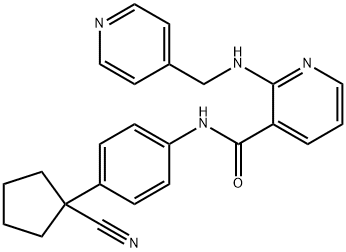Apatinib

|
- ₹0
- Product name: Apatinib
- CAS: 811803-05-1
- MF: C24H23N5O
- MW: 397.47
- EINECS:1592732-453-0
- MDL Number:MFCD22420814
- Synonyms:Apatinib;Apatinib (YN968D1);Aptinib;N-(4-(1-cyanocyclopentyl)phenyl)-2-(pyridin-4-ylMethylaMino)nicotinaMide;Mesylate APA;N-[4-(1-Cyanocyclopentyl)phenyl]-2-[(4-pyridinylmethyl)amino]-3-pyridinecarboxamide Apatinib;3-Pyridinecarboxamide, N-[4-(1-cyanocyclopentyl)phenyl]-2-[(4-pyridinylmethyl)amino]-;CS-1160
| Manufacturer | Product number | Product description | Packaging | Price | Updated | Buy |
|---|
Properties
Boiling point :578.2±50.0 °C(Predicted)
Density :1.27
storage temp. :Store at -20°C
solubility :>49.4mg/ml in DMSO
form :Powder
pka :11.93±0.70(Predicted)
Density :1.27
storage temp. :Store at -20°C
solubility :>49.4mg/ml in DMSO
form :Powder
pka :11.93±0.70(Predicted)
Safety Information
| Symbol(GHS): |

|
|||||||||||||||||||||||||||||||||||
|---|---|---|---|---|---|---|---|---|---|---|---|---|---|---|---|---|---|---|---|---|---|---|---|---|---|---|---|---|---|---|---|---|---|---|---|---|
| Signal word: | Warning | |||||||||||||||||||||||||||||||||||
| Hazard statements: |
|
|||||||||||||||||||||||||||||||||||
| Precautionary statements: |
|
Description
Apatinib mesylate, discovered by Advenchen Laboratories (United States of America, USA) and co-developed by Jiangsu Hengrui Medicine Co. Ltd (China), was approved by the Chinese Food and Drug Administration (CFDA) in October 2014 for the treatment of metastatic gastric carcinoma. Apatinib mesylate is an oral tyrosine kinase inhibitor that selectively inhibits the vascular endothelial growth factor receptor 2 (VEGFR2), which prevents new blood vessel formation selectively in tumor tissue. Apatinib has shown inhibition of the VEGF signaling pathway with an IC50 value of 1 nM for VEGFR-2 in in vitro enzyme experiments. A multicenter phase II study of apatinib is underway with patients in non-triple-negative metastatic breast cancer trials. Non-clinical studies concluded that apatinib may reverse the ATP-binding cassette subfamily B member 1 and subfamily G member 2 (ABCB1- and ABCG2, respectively)-mediated multidrug resistance which allows cancer cells to circumvent certain conventional antineoplastic drugs, suggesting that apatinib could be effective as a combination therapy.More related product prices
918504-65-1 Sunitinib Malate ABT 737 Nilotinib AMG 900 Bortezomib RofecoxibRelated product price
- Sunitinib Malate
₹15891.1-63477.8 - ABT 737
₹15910 - Bortezomib
₹12940






